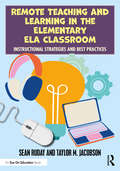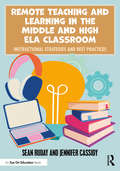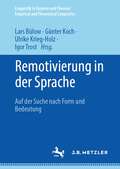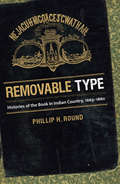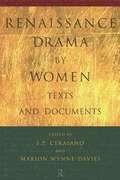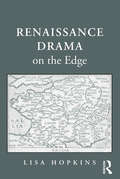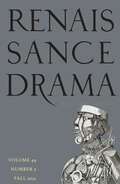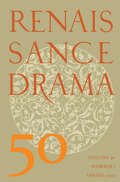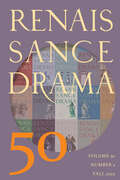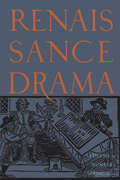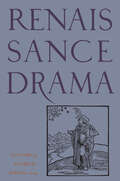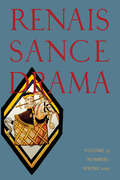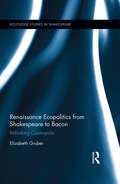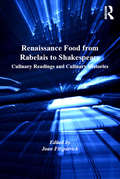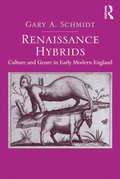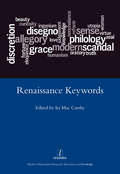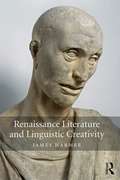- Table View
- List View
Remote Teaching and Learning in the Elementary ELA Classroom: Instructional Strategies and Best Practices
by Sean Ruday Taylor M. JacobsonTeaching in remote, distance, and hybrid environments can be overwhelming and confusing and poses many challenges for novice and veteran teachers alike. In this comprehensive and practice-ready book, you’ll find clear ideas for implementing the best practices of English-language instruction in remote teaching settings. Understanding that remote teaching looks different in each subject, Ruday and Jacobson identify methods specifically designed for elementary ELA classrooms. Designed for use in remote, hybrid, and hyflex environments with synchronous or asynchronous learning, this resource gives teachers a toolbox of research-backed recommendations, ideas, examples, and practices for teaching in unpredictable and new environments. Ruday and Jacobson address essential topics, including writing, grammar, and reading instruction; assessment; differentiation; culturally relevant teaching; family engagement and communication; technology; professional self-care; and more. Teachers will come away with ready-to-implement strategies and insights for high-quality instruction that can be adapted to any kind of remote learning environment.
Remote Teaching and Learning in the Middle and High ELA Classroom: Instructional Strategies and Best Practices
by Sean Ruday Jennifer CassidyTeaching in remote, distance, and hybrid environments can be overwhelming and confusing and poses many challenges for novice and veteran teachers alike. This book guides teachers through the best practices of English language arts (ELA) instruction and helps them reflect on ways to apply those practices in remote learning and envision future instruction that draws from the most useful aspects of educational innovations. Understanding that remote teaching looks different in each subject, Ruday and Cassidy identify methods specifically designed for middle and high school ELA classrooms. Designed for use in remote, hybrid, and hyflex environments with synchronous or asynchronous learning, this resource gives teachers a toolbox of research-backed recommendations, ideas, examples, and practices for teaching in unpredictable and new environments. Ruday and Cassidy address essential topics, including writing, grammar, and reading instruction; assessment; differentiation; culturally relevant teaching; family engagement and communication; technology; professional self-care; and more. Teachers will come away with ready-to-implement strategies and insights for high-quality instruction that can be adapted to any kind of remote learning environment.
Remotivierung in der Sprache: Auf der Suche nach Form und Bedeutung (Linguistik in Empirie und Theorie/Empirical and Theoretical Linguistics)
by Günter Koch Igor Trost Lars Bülow Ulrike Krieg-HolzDie Beiträge des Bandes befassen sich aus synchroner und diachroner Perspektive mit Reanalyse-Prozessen, die unter dem Schlagwort sprachliche Remotivierung zusammengefasst werden können. Dabei handelt es sich im weitesten Sinne formseitig um remotivierende Resegmentierungen und inhaltsseitig um semantische Remotivierungen. Das Buch bietet einen Überblick über Prozesse sprachlicher Remotivierung in verschiedenen Verwendungsdomänen, in denen sprachlichen Zeichen eine zentrale Funktion zukommt.
Removable Type
by Phillip H. RoundIn 1663, the Puritan missionary John Eliot, with the help of a Nipmuck convert whom the English called James Printer, produced the first Bible printed in North America. It was printed not in English but in Algonquian, making it one of the first books printed in a Native language. In this ambitious and multidisciplinary work, Phillip Round examines the relationship between Native Americans and printed books over a two-hundred-year period, uncovering the individual, communal, regional, and political contexts for Native peoples' use of the printed word. From the northeastern woodlands to the Great Plains, Round argues, alphabetic literacy and printed books mattered greatly in the emergent, transitional cultural formations of indigenous nations threatened by European imperialism. Removable Typeshowcases the varied ways that Native peoples produced and utilized printed texts over time, approaching them as both opportunity and threat. Surveying this rich history, Round addresses such issues as the role of white missionaries and Christian texts in the dissemination of print culture in Indian Country, the establishment of "national" publishing houses by tribes, the production and consumption of bilingual texts, the importance of copyright in establishing Native intellectual sovereignty (and the sometimes corrosive effects of reprinting thereon), and the significance of illustrations.
Renaissance Beasts: Of Animals, Humans, and Other Wonderful Creatures
by Erica FudgeAnimals, as Lévi-Strauss wrote, are good to think with. This collection addresses and reassesses the variety of ways in which animals were used and thought about in Renaissance culture, challenging contemporary as well as historic views of the boundaries and hierarchies humans presume the natural world to contain. Taking as its starting point the popularity of speaking animals in sixteenth-century literature and ending with the decline of the imperial Ménagerie during the French Revolution, Renaissance Beasts uses the lens of human-animal relationships to view issues as diverse as human status and power, diet, civilization and the political life, religion and anthropocentrism, spectacle and entertainment, language, science and skepticism, and domestic and courtly cultures. Within these pages scholars from a variety of disciplines discuss numerous kinds of texts--literary, dramatic, philosophical, religious, political--by writers including Calvin, Montaigne, Sidney, Shakespeare, Descartes, Boyle, and Locke. Through analysis of these and other writers, Renaissance Beasts uncovers new and arresting interpretations of Renaissance culture and the broader social assumptions glimpsed through views on matters such as pet ownership and meat consumption. Renaissance Beasts is certainly about animals, but of the many species discussed, it is ultimately humankind that comes under the greatest scrutiny.
Renaissance Comedy
by Don Beecher The Da Ponte LibraryA rich and multi-faceted aspect of the Italian Renaissance, the comedy has been largely overlooked as a cultural force during the period. In Renaissance Comedy, editor Donald Beecher corrects this oversight with a collection of eleven comedies representative of the principal styles of writing that define the genre. Proceeding from early, ?erudite? imitations of Plautus and Terence to satires, sentimental plays of the middle years, and later, more experimental works, the development of Italian Renaissance comedy is here dissected in a fascinating and vivid light.This first of two volumes boasts five of the best-known plays of the period, each with its own historical and critical introduction. Also included is a general introduction by the editor, which discusses the features of Italian Renaissance comedy, as well as examines the stage histories of the plays and what little is known, in many cases, of the circumstances surrounding their original performances. The introduction raises questions concerning the nature of audiences, the festival occasions during which the plays were performed, and the academies which sponsored many of their creations.As a much-needed reappraisal of these comedic plays, Renaissance Comedy is an invaluable look at the performance history of the Renaissance and Italian culture in general.
Renaissance Drama By Women: Texts And Documents
by Marion Wynne-Davies S. P. CerasanoRenaissance Drama By Women is a unique volume of plays and documents. For the first time, it demonstrates the wide range of theatrical activity in which women were involved during the Renaissance period. It includes full-length plays, a translated fragment by Queen Elizabeth I, a masque, and a substantial number of historical documents. With full and up-to-date accompanying critical material, this collection of texts is an exciting and invaluable resource for use in both the classroom and research. Special features introduced by the editors include: * introductory material to each play * modernized spellings * extensive notes and annotations * biographical essays on each playwright * a complete bibliography Methodically and authoritatively edited by S.P. Cerasano and Marion Wynne-Davies, Renaissance Drama by Women is a true breakthrough for the study of women's literature and performance.
Renaissance Drama and the English Church Year
by Rudolph Chris Hassel Jr.Evidence encouraging a new and productive approach to Renaissance drama has long been available in the records of Renaissance court perfon-nances compiled by E. K. Chambers and Gerald Eades Bentley.' Over fifty years ago Chambers noticed the persistent correlation between the dates of dramatic performance at Elizabeth's court and certain liturgical festivals of the English church year. Whether in Whitehall or elsewhere, the twelve days of Christmas from the Nativity to the Epiphany, were a season of high revels.... Twelfth Night [6 Jan.] itself, with St. Stephen's [26 Dec.] , St. John's [27 Dec.], Innocents' [28 Dec.], and New Year's Day [circumcision], were regularly appointed for plays and masks, which often overflowed on to other nights during the period.... The revels were renewed for Candlemas [2 Feb.] and for Shrovetide [Sunday, Monday, and Tuesday before Ash Wednesday] , either at the Christmas headquarters or at some other palace to which the court had meanwhile removed. . . . Easter, with the distribution of alms and washing of feet on Maunday Thursday, and Whitsuntide, were kept as ecclesiastical, rather than secular feasts. [1: 19-201 Gradually emerging during the sixteenth century, this calendar tradition seems to have peaked in the period 1570-85, continued strong until Elizabeth's death, diminished and changed somewhat during the Jacobean and Caroline periods, and then disappeared completely after 1640.
Renaissance Drama by Women: Texts and Documents
by Marion Wynne-Davies S. P. Cerasano<p>Gathered for the first time in this unique volume are plays and documents which show that, contrary to traditional thinking, women did participate in the theatrical culture of the Renaissance. Women were authors, translators, performers, spectators, and even part-owners of theatres. <p>Included in this meticulously edited volume are four full-length plays, a fragment of a translation from Seneca by Queen Elizabeth I, a masque written for performance by a ladies’ school before Queen Anne and a collection of historical documents. <p><i>Renaissance Drama by Women: Texts and Documents</i> is the first collection to offer such a wealth of literary and historical material. The editors assist the reader in understanding the richness of the texts by providing modernized spellings, full notes, annotations of unfamiliar words and phraseology, biographical essays and a bibliography. This volume will be invaluable to students and scholars of Renaissance studies, theatre history and women’s studies.</p>
Renaissance Drama on the Edge
by Lisa HopkinsRecurring to the governing idea of her 2005 study Shakespeare on the Edge, Lisa Hopkins expands the parameters of her investigation beyond England to include the Continent, and beyond Shakespeare to include a number of dramatists ranging from Christopher Marlowe to John Ford. Hopkins also expands her notion of liminality to explore not only geographical borders, but also the intersection of the material and the spiritual more generally, tracing the contours of the edge which each inhabits. Making a journey of its own by starting from the most literally liminal of physical structures, walls, and ending with the wholly invisible and intangible, the idea of the divine, this book plots the many and various ways in which, for the Renaissance imagination, metaphysical overtones accrued to the physically liminal.
Renaissance Drama, volume 49 number 2 (Fall 2021)
by Renaissance DramaThis is volume 49 issue 2 of Renaissance Drama. Renaissance Drama explores the rich variety of theatrical and performance traditions and practices in early modern Europe and intersecting cultures. The sole scholarly journal devoted to the full expanse of Renaissance theatre and performance, the journal publishes articles that extend the scope of our understanding of early modern playing, theatre history, and dramatic texts and interpretation, encouraging innovative theoretical and methodological approaches to these traditions, examining familiar works, and revisiting well-known texts from fresh perspectives.
Renaissance Drama, volume 50 number 1 (Spring 2022)
by Renaissance DramaThis is volume 50 issue 1 of Renaissance Drama. Renaissance Drama explores the rich variety of theatrical and performance traditions and practices in early modern Europe and intersecting cultures. The sole scholarly journal devoted to the full expanse of Renaissance theatre and performance, the journal publishes articles that extend the scope of our understanding of early modern playing, theatre history, and dramatic texts and interpretation, encouraging innovative theoretical and methodological approaches to these traditions, examining familiar works, and revisiting well-known texts from fresh perspectives.
Renaissance Drama, volume 50 number 2 (Fall 2022)
by Renaissance DramaThis is volume 50 issue 2 of Renaissance Drama. Renaissance Drama explores the rich variety of theatrical and performance traditions and practices in early modern Europe and intersecting cultures. The sole scholarly journal devoted to the full expanse of Renaissance theatre and performance, the journal publishes articles that extend the scope of our understanding of early modern playing, theatre history, and dramatic texts and interpretation, encouraging innovative theoretical and methodological approaches to these traditions, examining familiar works, and revisiting well-known texts from fresh perspectives.
Renaissance Drama, volume 51 number 1 (Spring 2023)
by Renaissance DramaThis is volume 51 issue 1 of Renaissance Drama. Renaissance Drama explores the rich variety of theatrical and performance traditions and practices in early modern Europe and intersecting cultures. The sole scholarly journal devoted to the full expanse of Renaissance theatre and performance, the journal publishes articles that extend the scope of our understanding of early modern playing, theatre history, and dramatic texts and interpretation, encouraging innovative theoretical and methodological approaches to these traditions, examining familiar works, and revisiting well-known texts from fresh perspectives.
Renaissance Drama, volume 51 number 2 (Fall 2023)
by Renaissance DramaThis is volume 51 issue 2 of Renaissance Drama. Renaissance Drama explores the rich variety of theatrical and performance traditions and practices in early modern Europe and intersecting cultures. The sole scholarly journal devoted to the full expanse of Renaissance theatre and performance, the journal publishes articles that extend the scope of our understanding of early modern playing, theatre history, and dramatic texts and interpretation, encouraging innovative theoretical and methodological approaches to these traditions, examining familiar works, and revisiting well-known texts from fresh perspectives.
Renaissance Drama, volume 52 number 1 (Spring 2024)
by Renaissance DramaThis is volume 52 issue 1 of Renaissance Drama. Renaissance Drama explores the rich variety of theatrical and performance traditions and practices in early modern Europe and intersecting cultures. The sole scholarly journal devoted to the full expanse of Renaissance theatre and performance, the journal publishes articles that extend the scope of our understanding of early modern playing, theatre history, and dramatic texts and interpretation, encouraging innovative theoretical and methodological approaches to these traditions, examining familiar works, and revisiting well-known texts from fresh perspectives.
Renaissance Drama, volume 52 number 2 (Fall 2024)
by Renaissance DramaThis is volume 52 issue 2 of Renaissance Drama. Renaissance Drama explores the rich variety of theatrical and performance traditions and practices in early modern Europe and intersecting cultures. The sole scholarly journal devoted to the full expanse of Renaissance theatre and performance, the journal publishes articles that extend the scope of our understanding of early modern playing, theatre history, and dramatic texts and interpretation, encouraging innovative theoretical and methodological approaches to these traditions, examining familiar works, and revisiting well-known texts from fresh perspectives.
Renaissance Drama, volume 53 number 1 (Spring 2025)
by Renaissance DramaThis is volume 53 issue 1 of Renaissance Drama. Renaissance Drama explores the rich variety of theatrical and performance traditions and practices in early modern Europe and intersecting cultures. The sole scholarly journal devoted to the full expanse of Renaissance theatre and performance, the journal publishes articles that extend the scope of our understanding of early modern playing, theatre history, and dramatic texts and interpretation, encouraging innovative theoretical and methodological approaches to these traditions, examining familiar works, and revisiting well-known texts from fresh perspectives.
Renaissance Drama: An Anthology of Plays and Entertainments (Blackwell Anthologies)
by Arthur F. Kinney David A. KatzRENAISSANCE DRAMA Experience the best and most noteworthy works of Renaissance dramaThis Third Edition of Renaissance Drama: An Anthology of Plays and Entertainments is the latest installment of a groundbreaking collection of non-Shakespearean Renaissance drama. Covering not only the popular drama of the period, Renaissance Drama includes masques, Lord Mayor shows, royal performances, and the popular mystery plays of the time. The selections fairly represent the variety and quality of Renaissance drama and they include works of scholarly and literary interest.Each work included in this edition comes with an insightful and illuminating introduction that places the piece in its historical and cultural context, with accompanying text explaining the significance of each piece and the ways in which it interacts with other works.New to this edition are:The famous entertainment for Elizabeth at KenilworthGeorge Peele’s remarkably inventive The Old Wives’ TaleThe oft-forgotten history of Thomas of Woodstock, predecessor to Shakespeare’s Richard IIJohn Lyly’s Gallathea, a work which explores gender and love, written for the Children’s Company at Saint Paul’sBen Johnson’s Volpone and the controversial EpicoenePerfect for scholars, teachers, and readers of the English Renaissance, Renaissance Drama: An Anthology of Plays and Entertainments belongs on the bookshelves of anyone with even a passing interest in the drama of its time.
Renaissance Ecopolitics from Shakespeare to Bacon: Rethinking Cosmopolis (Routledge Studies in Shakespeare)
by Elizabeth D. GruberThe work of Shakespeare and his contemporaries has often been the testing-ground for innovations in literary studies, but this has not been true of ecocriticism. This is partly because, until recently, most ecologically minded writers have located the origins of ecological crisis in the Enlightenment, with the legacies of the Cartesian cogito singled out as a particular cause of our current woes. Traditionally, Renaissance writers were tacitly (or, occasionally, overtly) presumed to be oblivious of environmental degradation and unaware that the episteme—the conceptual edifice of their historical moment—was beginning to crack. This perception is beginning to change, and Dr. Guber's work is poised to illuminate the burgeoning number of ecocritical studies devoted to this period, in particular, by showing how the classical concept of the cosmopolis, which posited the harmonious integration of the Order of Nature (cosmos) with the Order of Society (polis), was at once revived and also systematically dismantled in the Renaissance. Renaissance Ecopolitics from Shakespeare to Bacon: Rethinking Cosmopolis demonstrates that the Renaissance is the hinge, the crucial turning point in the human-nature relationship and examines the persisting ecological consequences of the nature-state’s demise.
Renaissance Figures of Speech
by Gavin Alexander Sylvia Adamson Katrin EttenhuberThe Renaissance saw a renewed and energetic engagement with classical rhetoric; recent years have seen a similar revival of interest in Renaissance rhetoric. As Renaissance critics recognised, figurative language is the key area of intersection between rhetoric and literature. This book is the first modern account of Renaissance rhetoric to focus solely on the figures of speech. It reflects a belief that the figures exemplify the larger concerns of rhetoric, and connect, directly or by analogy, to broader cultural and philosophical concerns within early modern society. Thirteen authoritative contributors have selected a rhetorical figure with a special currency in Renaissance writing and have used it as a key to one of the period's characteristic modes of perception, forms of argument, states of feeling or styles of reading.
Renaissance Food from Rabelais to Shakespeare: Culinary Readings and Culinary Histories
by Joan FitzpatrickProviding a unique perspective on a fascinating aspect of early modern culture, this volume focuses on the role of food and diet as represented in the works of a range of European authors, including Shakespeare, from the late medieval period to the mid seventeenth century. The volume is divided into several sections, the first of which is "Eating in Early Modern Europe"; contributors consider cultural formations and cultural contexts for early modern attitudes to food and diet, moving from the more general consideration of European and English manners to the particular consideration of historical attitudes toward specific foodstuffs. The second section is "Early Modern Cookbooks and Recipes," which takes readers into the kitchen and considers the development of the cultural artifact we now recognize as the cookbook, how early modern recipes might "work" today, and whether cookery books specifically aimed at women might have shaped domestic creativity. Part Three, "Food and Feeding in Early Modern Literature" offers analysis of the engagement with food and feeding in key literary European and English texts from the early sixteenth to the early seventeenth century: François Rabelais's Quart livre, Shakespeare's plays, and seventeenth-century dramatic prologues. The essays included in this collection are international and interdisciplinary in their approach; they incorporate the perspectives of historians, cultural commentators, and literary critics who are leaders in the field of food and diet in early modern culture.
Renaissance Hybrids: Culture and Genre in Early Modern England
by Gary A. SchmidtIn the first book-length study explicitly to connect the postcolonial trope of hybridity to Renaissance literature, Gary Schmidt examines how sixteenth- and seventeenth-century English authors, artists, explorers and statesmen exercised a concerted effort to frame questions of cultural and artistic heterogeneity. This book is unique in its exploration of how 'hybrid' literary genres emerge at particular historical moments as vehicles for negotiating other kinds of hybridity, including but not limited to cultural and political hybridity. In particular, Schmidt addresses three distinct manifestations of 'hybridity' in English literature and iconography during this period. The first category comprises literal hybrid creatures such as satyrs, centaurs, giants, and changelings; the second is cultural hybrids reflecting the mixed status of the nation; and the third is generic hybrids such as the Shakespearean 'problem play,' the volatile verse satires of Nashe, Hall and Marston, and the tragicomedies of Beaumont and Fletcher. In Renaissance Hybrids, Schmidt demonstrates 'postmodern' considerations not to be unique to our own critical milieu. Rather, they can fruitfully elucidate cultural and literary developments in the English Renaissance, forging a valuable link in the history of ideas and practices, and revealing a new dimension in the relation of early modern studies to the concerns of the present.
Renaissance Keywords
by ItaMac CarthyCertain words played a crucial role in the making of the European Renaissance, and still recur today in our shifting understanding of it. Discretion and grace, to take two examples studied here, express how individuals thought about themselves, each other and their experience of the world, yet they are as hard to define as they are ever-present in Renaissance discourse. In this collection of essays, scholars from across the Humanities offer new interpretations of these and other 'keywords', to adopt Raymond Williams's term, and investigate the vocabulary that not only accompanied, but also produced, the cultural transformations that made the Renaissance so distinctive. A keywords approach to Renaissance Europe provides a rich contextual framework for the exploration of its central ideas. It also highlights the need for fresh thinking on current histories of the age. Seven Renaissance Keywords engages with the ongoing debate about the term 'Renaissance' itself, perhaps more our keyword than theirs, and seeks alternative ways to understand a culture and society which produced conceptions of the self as much as it did art and science. The result is an exploration at the cutting edge of contemporary research. Ita Mac Carthy is Lecturer in Italian Studies at the University of Birmingham.
Renaissance Literature and Linguistic Creativity
by James HarmerRenaissance Literature and Linguistic Creativity interrogates notions of linguistic creativity as presented in English literary texts of the late sixteenth century. It considers the reflections of Renaissance English writers upon the problem of how linguistic meaning is created in their work. The book achieves this consideration by placing its Renaissance authors in the context of the dominant conceptualisation of the thought-language relationship in the Western tradition: namely, that of 'introspection'. In taking this route, author James Harmer undertakes to provide a comprehensive overview of the notion of 'introspection' from classical times to the Renaissance, and demonstrates how complex and even strange this notion is often seen to be by thinkers and writers. Harmer also shows how poetry and literary discourse in general stands at the centre of the conceptual consideration of what linguistic thinking is. He then argues, through a range of close readings of Renaissance texts, that writers of the Shakespearean period increase the fragility of the notion of 'introspection' in such a way as to make the prospect of any systematic theory of meaning seem extremely remote. Embracing and exploring the possibility that thinking about meaning can only occur in the context of extreme cognitive and psychological limitation, these texts emerge as proponents of a human mind which is remarkably free in its linguistic nature; an irresistible mode of life unto itself. The final argumentative stratum of the book explores the implications of this approach for understanding the relationship between literary criticism, philosophy, and other kinds of critical activity. Texts discussed at length include Edmund Spenser's The Faerie Queene and shorter poetry, George Chapman's Ovids Banquet of Sence, Shakespeare's Titus Andronicus and Hamlet, and John Donne's Elegies.
